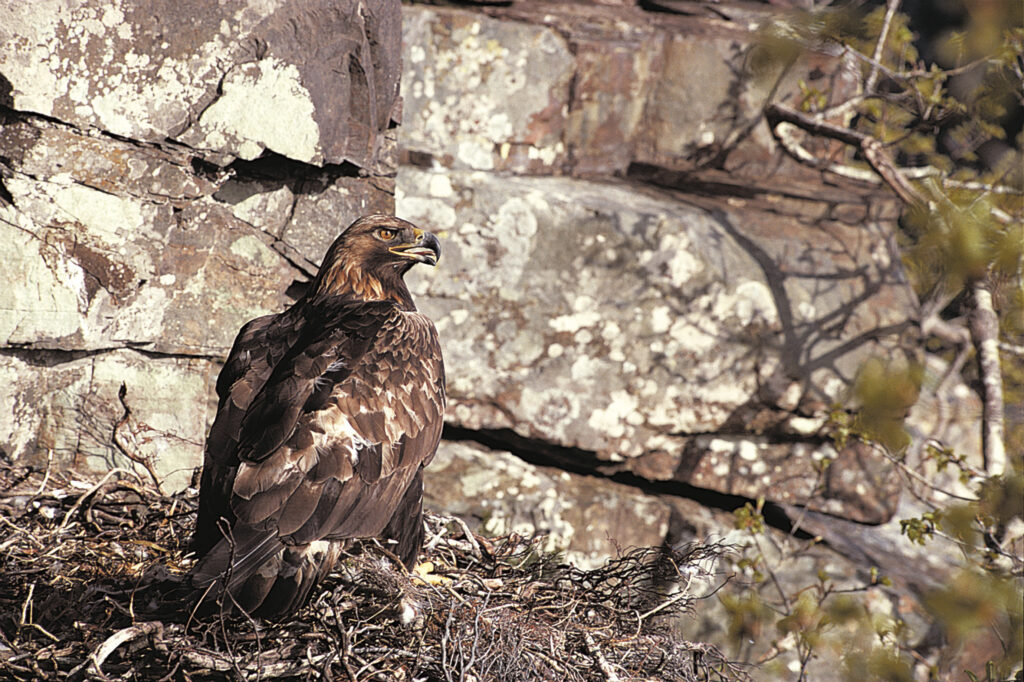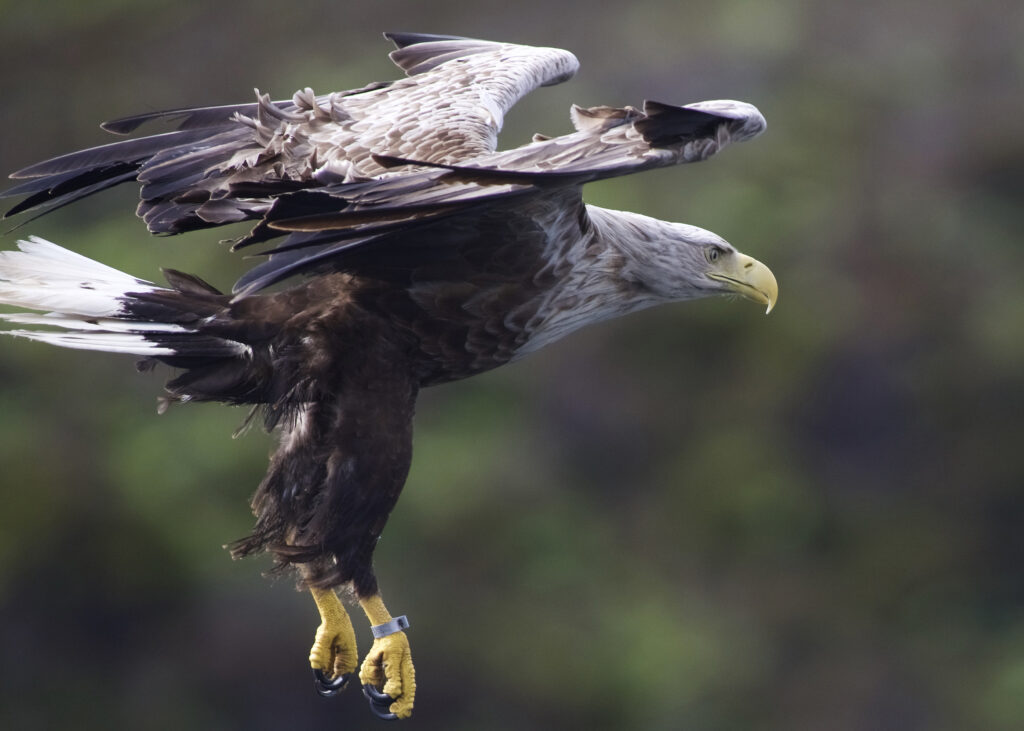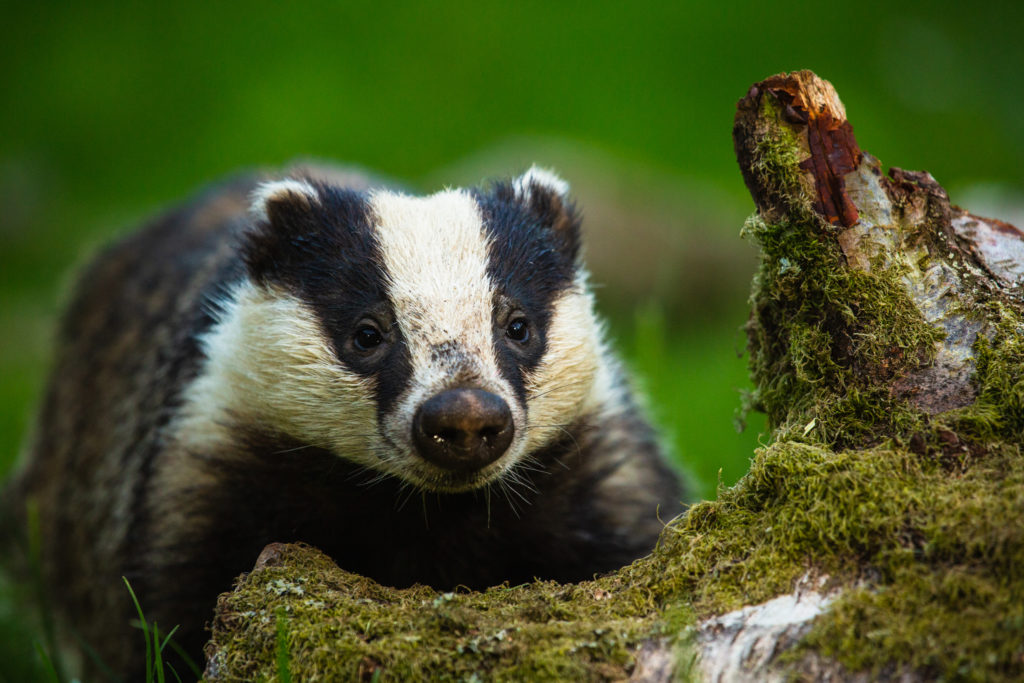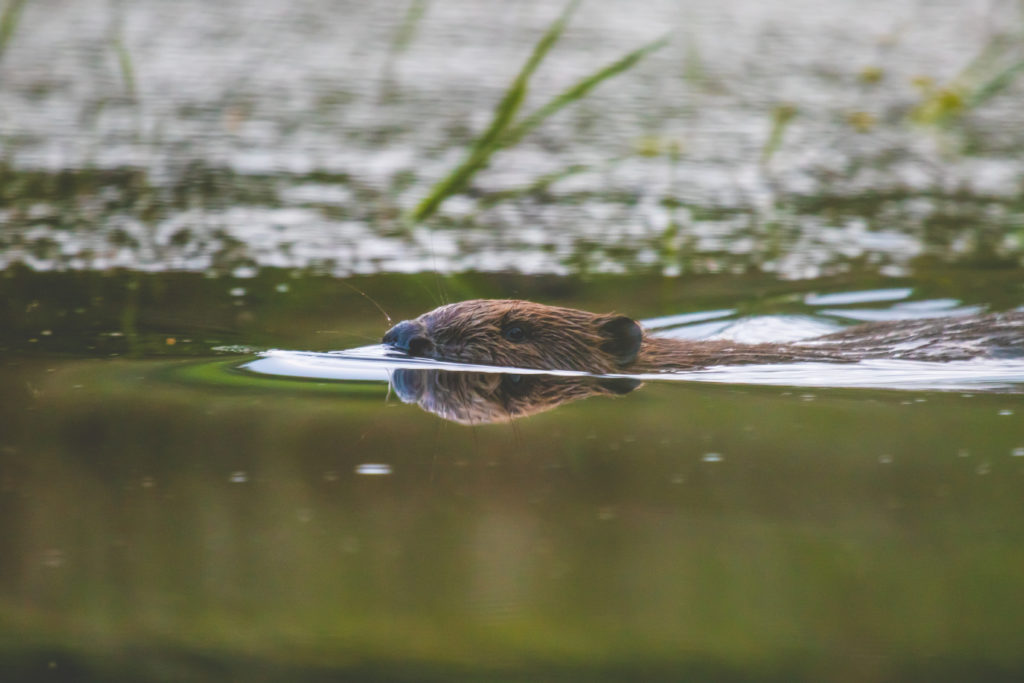In the fourth part of the series exploring the species that have disappeared from Cumbria’s landscape, Haweswater Site Manager Lee Schofield traces the rise and fall of our two native eagles, both of which have a special place in the wild history of Haweswater
For most of the last five decades, Haweswater was the only place in England where golden eagles resided. They returned in 1969 thanks to a healthy and expanding population in Southern Scotland. Haweswater’s pair nested first on Harter Fell, the imposing lump that looks over the southern end of the reservoir, but quickly moved over into neighbouring Riggindale, where a short lineage remained until the demise of the last male in 2015. Cumbria, and England as a whole, has been without eagles ever since.

Golden eagle at nest (RSPB Images)
The return of eagles to the Lake District 50 years ago was a matter of great excitement for anyone interested in nature. The RSPB, doing what it does best, sprang into action to protect them. To give the birds the best chance of success, a round-the-clock nest-guarding programme was established, defending against egg-theft, a depressingly realistic prospect at that time.
In no small part thanks to those efforts, the king of birds persisted in Riggindale. Over 46 years, two female and three male eagles made their home in the valley, with new birds arriving to keep the pair intact as one or other of the group passed away. They successfully reared young in 16 of the years they were there. However, the last male, who died in 2015, spent the last 12 years alone, with no female for company. His annual displays to attract a mate every spring seemed to become less enthusiastic as the years went past, a poignant symbol of wildness bleeding out of these mountains.
Golden eagles are the world’s most widely distributed species of eagle, found throughout Europe, Asia, North America and Northern Africa. They establish huge territories through which they roam in search of prey. With a wingspan of 2.2m and their golden-brown plumage they are truly majestic birds, but their shy and secretive nature, and preference for wild lonely places, mean that few people ever get the chance to see them up close.
Before their 1969 return, Lakeland had been without breeding eagles for at least 150 years. But there is ample evidence that eagles were part of our landscape since time immemorial, and not just one species of eagle either. Glance over any of the Lake District ordnance survey sheets, and it won’t be long before you spot an Eagle Crag.

OS Map of Riggindale, Haweswater, showing both Eagle and Heron Crag (Bing Maps)
There are also lots of Heron and Iron Crags. Herons don’t nest on crags, and many of the iron crags are nowhere near iron-mining areas. Both of these names are actually derivations of erne, an alternative name for white-tailed eagle.
Haweswater has an important place in the history of these even larger eagles too. The first trustworthy account for a white-tailed eagle eyrie was from 1692, on Walla Crag, which stands woody and imposing overlooking the Haweswater dam, and less than a mile from my desk at RSPB Haweswater HQ. In 1892, Reverend Macpherson published a detailed account of the wildlife of Lakeland in which he documents the rise and fall of eagles. The sections on both eagle species are lengthy, including several first-hand accounts of people who had seen them in their lifetimes. The locations of eagle nests were generally well known, predominantly in order to aid the theft of their eggs and the killing or capture of the birds.
Eagles have probably always lived uncomfortably alongside humans. As a top predator, they compete with us for food, and their ability to carry off newborn lambs, domestic fowl and even cats and dogs would have secured their place on a list of vermin warranting destruction.
The pressure on these birds increased in the Victorian period where the war on wildlife intensified alongside a growing interest in recreational shooting and the rise of the gamekeeper. Birds of prey became public enemy number one during this time. As the local human population and their livestock numbers increased there was to be no let up for the eagles. Macpherson describes harrowing episodes of the destruction of both adult birds and eggs, including an account of the eggs of that same Haweswater nest on Walla Crag being robbed in 1787.

White-tailed eagle Outer Hebrides, Scotland (RSPB Images)
There were occasional sightings of white-tailed eagles for a few years after that, but no more of these giants of the sky bred in Cumbria beyond 1800. By 1920, they were gone completely from the UK as a whole.
Perhaps more so than any other bird, golden eagles are birds of wild and lonely places, shunning people wherever possible. White-tailed eagles are not so choosy. This is probably the main reason that white-tailed eagles were completely wiped out in the UK, whereas golden eagles managed to hang on; they were simply harder to find and to get to.
White-tailed eagles, also sometimes referred to as sea eagles, are as much at home on the coast catching fish as they are further inland. This adaptability explains why white-tailed eagles historically hugely outnumbered golden eagles.
Both our eagle species have had a torrid time over the last 200 years, but in the last couple of decades their fortunes have started to improve. Thanks to a successful reintroduction programme in Scotland using birds from Norway, white-tailed eagles have returned. In 2019 a new batch of these flying barn doors were released on the Isle of Wight. One of these newcomers went for a ramble around the South East almost as soon as it was released, even being spotted over London by a handful of stunned urbanites.
Thanks to legal protection, golden eagles are also on the up with numbers exceeding 500 pairs in 2015. However, they are almost all north of Scotland’s central belt, bar a few pairs in the borders. A new project to boost this small and vulnerable southern population translocated young golden eagles in 2018 and 2019.
What about the Lake District? If the southern Scottish project goes according to plan, then there should be a much healthier population producing golden eagles that would be looking to set up new homes on our doorstep. Juvenile golden eagles can roam hundreds of miles in search of new breeding territories. As far as an eagle is concerned, the Lake District is part of the same landscape as the Scottish Borders; they don’t see any national divide.
Sea eagles are already expanding their territory from Scotland. And now, there is the potential that they might start spreading north from the Isle of Wight too. Both species of eagle are seen drifting through Cumbria from time to time, and it’s surely only a matter of time before one or the other decides to call the Lake District home again.
Studies have shown that golden eagles seem to have a preference for a particular type of location for nesting. Favoured crags can be used, abandoned for years and then resettled. Perhaps one day, one of our Eagle Crags will live up to its name again.
There is a huge amount of positive conservation work happening in the Lake District at the moment. Livestock numbers are being reduced alongside other targeted action to help natural bog, heath, woodland and scrub habitats to recover. A healthier mosaic of habitats in our hills and valleys should mean healthier populations of prey for eagles to eat. The return of eagles to Lakeland would be the ultimate accolade, a symbol of our ability to live alongside wild nature once again.
Find out more about golden eagles here and about white-tailed eagles here


